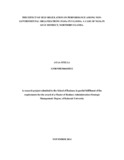THE EFFECT OF SELF-REGULATION ON PERFORMANCE AMONG NONGOVERNMENTAL ORGANIZATIONS (NGOs) IN UGANDA: A CASE OF NGOs IN GULU DISTRICT, NORTHERN UGANDA.
Abstract
The developing world, including Uganda, has experienced an explosive growth in the number
and types of non-governmental organizations (NGOs) in recent decades. These “third sector”
organizations have become important in filling the service delivery gaps especially in health
and education.
Using the case of the NGOs in Gulu District, this study proposed to examine the effect of
self-regulation strategy on the performance of NGOs in Uganda. Applying a descriptive
research approach, the study sought to establish the relationship between, on the one side,
Forms self-regulation mechanism, NGO accountability, transparency policies, and flexibility
of NGO structures as independent variables, the NGO regulatory policy of central and local
government as intervening variable and NGO performance as a dependent variable, on the
other side. The methodology of used in the study was questionnaire and document review
methods, Likert scale was used to ease coding and analysis, stratified random sampling was
used to form the final study population of (60) NGOs, purposive sampling technique was also
used to select key informants respondents (8) from both central and local government
officials. The found out that all NGOs in the sample belong to at least one type of selfregulation mechanism, the study found that there was a significant positive relationship (with
a coefficient of 0.483 significant at 0.01) between adopting accountability standards as a selfregulation strategy and the performance of the NGO. The study showed that there was a
positive relationship between practicing transparency policies and the performance; it also
found that there is a positive relationship (correlation coefficient of .277 at 0.01 level of
significance) between flexibility of the NGO structure and performanceand that NGO
performance is greatly influenced by the central and local government regulation. In
conclusion, Data collected was analyzed using the Statistical Packages for the Social
Sciences (SPSS). Descriptive statistic analysis was carried out; inferential statistic was done
using the Pearson’s correlation coefficient and data generated from the statistical analysis
were then presented in both numerical and non-numerical forms.

